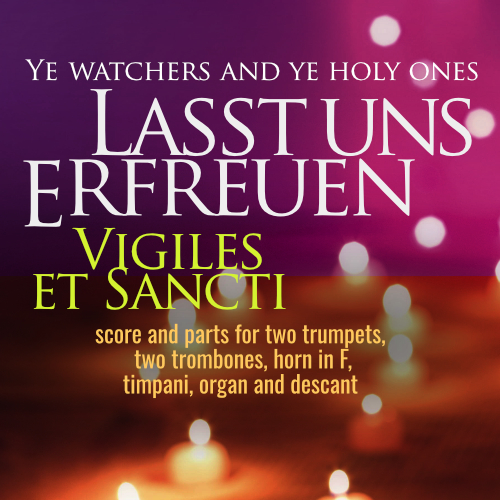Vigiles et sancti
A four-verse stting of Ye watchers and ye holy ones, Athelstan Riley's adaptation of the ancient Christian hymns Te Deum laudamus and Axion estin. This text appeared in The English Hymnal which was published in 1906, bearing the Latin name Vigiles et sancti. Political tensions interrupted the custom of naming German hymns according to the original first verse associated with the tune, the Easter hymn Lasst uns erfreuen herzlich sehr. This was an anonymous tune which first appeared in the Jesuit hymnal Ausserlesene Catholische Geistliche Kirchengesänge (Cologne, 1623, ed. Friedrich Spee, which quotes a century old Genevan antecedent).
About
Of particular interest to John Athelstan Riley (1858-1945) was the hymnology, rites, and thinking of the early church, its eastern branch paticularly. The hymn Ye watchers and ye holy ones is one that features many of the hierarchic orders present in these early writing, and forms the scaffolding of the work - and these orders come in threes:
The three fold celestial order - a trinity of trinities
- Seraphs, cherubim and thrones
- Dominions, Princedoms, powers
- Virtues, archangels, angels choirs
Then each verse goves us three more orders
- Higher than the cherubim, is Mary, the "bearer of the eternal Word" (cf Axion estin)
- The saints - the church triumphant - patriarchs, prophets, apostles, martyrs, and all saints who have left this earthly veil
- And the earthly church - the church militant - singing Alleluias to ....the Trinity
The image is of milia milum - from whence we derive militant - the thousands of thousands, the countless numbers of Christ's church on earth who will one day join the church triumphant.
A learned of Eton and Oxford, Riley was of Anglo-Catholic expression, and at one time traveled to Persia, Anatolia, and the middle east to study the worship of the Eastern church. Later he became a prominent figure in the development and publication of The English Hymnal, in which this hymn first appeared. Due to the cultural tensions of the time, the tune in England did not follow the taxonomy of German hymnody, which traditionally cites the tune not by a name, but by its original incipit. Like several German tunes, it was given a name -Vigiles et Sancti (watchers and holy ones).
This tune was the setting for the Easter hymn, Lasst uns erfreuen herzlich sehr, which celebrates the resurrection narrative from the perspective of Mary. It first appeared in the Jesuit hymnal Ausserlesene Catholische Geistliche Kirchengesänge (Cologne, 1623, ed. Friedrich Spee), and the setting quickly produced variants regarding the distribution of the alleluias. German literature usually attributes authorship of both the text and the tune to the collection's editor. As a poet and hymnologist, the attribution to him of the text is plausible; however there are no first-hand references to support an assertion of musical composition. Moreover, the opening phrase can be found in a tune 100 years earlier attributed to Matthäus Greiter and adapted to GENEVAN 36 and 68, published in 1525. Authoritative English language sources are devoid of the attribution. Originally rendered in common time, Ralph Vaughan Williams' harmonization rendered the music in the now more familiar 6/4 for the 1906 English Hymnal.
References
UMC Discipleship Ministries, History of Hymns: "Ye Watchers and Ye Holy Ones", C. Michael Hawn.
The Hymn Society of Great Britain and Ireland, Treasure No 46: The Tune ‘LASST UNS ERFREUEN’ as we know it
Henry, H. (1912). The Te Deum. In The Catholic Encyclopedia. New York: Robert Appleton Company. Retrieved May 5, 2023 from New Advent: http://www.newadvent.org/cathen/14468c.htm
Editions
Version 9.2.2
- First pubication of Vigiles et sancti
Intro / Brass / RVW / Descant / Brass - Shorter prologue (P2)
- Minor voice leading revisions
- Improved parts layout
- Vocal part prints duplex 11x1
----Previous Versions ----
Version 9.1.1
- Revised cadence to lower penultimate note in descant
- Voice leading revisions brass instruments
- Correction in descant to remove a parallel
- Adds All Creatures of our God and King
8.10.2
- Revised and shortened the Prologue
- Other minor revisions to organ, brass parts
- Simplified parts sets
8.7.6
- Initial publication
Verses
1 w brassYe watchers and ye holy ones,
Bright seraphs, cherubim, and thrones,
Raise the glad strain, Alleluia!
Cry out, dominions, princedoms, powers,
Virtues, archangels, angels' choirs,
Alleluia, alleluia, alleluia, alleluia! Alleluia!
2 rvw 1906
O higher than the cherubim,
more glorious than the seraphim,
lead their praises, Alleluia!
Thou bearer of the eternal Word,
most gracious, magnify the Lord,
Alleluia, alleluia, alleluia, alleluia! Alleluia!
3 descant
Respond, ye souls in endless rest,
Ye patriarchs and prophets blest,
Alleluia, Alleluia!
Ye holy Twelve, ye martyrs strong,
All saints triumphant raise the song,
Alleluia, alleluia, alleluia, alleluia! Alleluia!
4 w brass
O friends, in gladness let us sing,
supernal anthems echoing,
Alleluia, Alleluia!
To God the Father, God the Son,
And God the Spirit, Three in One,
Alleluia, alleluia, alleluia, alleluia! Alleluia!


